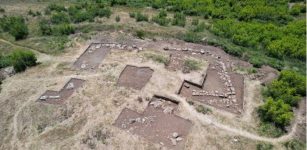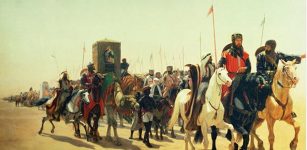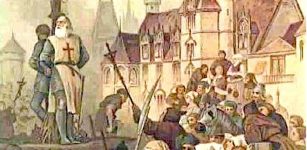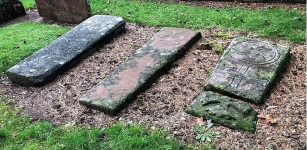Vikings Had Dark Humor And Joked Even During Deadly Battles
Ellen Lloyd - AncientPages.com - Historical studies of Icelandic Sagas reveal Vikings had dark humor and joked even during deadly battles.
It was a mixture of sarcasm, irony, and unusual jokes. The Vikings' approach was that if you knew you were going to die, why not do it laughing?
Credit: Adobe Stock - van Koop
Death was never something Vikings feared because they believed that a warrior who died in battle was rewarded and could join all other great fighters in Valhalla, a majestic, enormous hall located in Asgard, ruled over by the great god Odin.
Written during the Middle Ages, Icelandic Sagas tell stories of Vikings, and usually, the tales all centered around various kinds of disputes that ended in battles between the Vikings. Often, two or more families could be involved in blood feuds that lasted decades or generations.
According to historian Trine Buhl at the Århus University in Denmark, authors of the Icelandic Sagas deliberately added dark humor to their tales. Without it, the stories would be boring.
Icelandic Sagas are full of Viking jokes, dark humor and sarcasm. Credit: Public Domain
There are several examples of sarcasm and dark humor in the Sagas. For instance, the Droplaugarsona Saga, written sometime in the 13th century, tells about Droplaug's two sons, Grímr and Helgi.
When the Viking Helgi gets his lower lip cut off in a battle, he says to his opponent:
"I have never been particularly handsome and you haven't exactly improved my attractiveness."
This remark shows Viking Helgi possessed self-knowledge and self-deprecating humor.
A Viking warrior never feared death. Credit: Adobe Stock - Salsabila Ariadina
The Laxdœla saga also showcases Viking humor. In it, a fierce, hot-tempered Viking woman meets a ghost at night. She scolds the apparition so harshly that it immediately flees.
In the Gunnlaug Ormstungas Saga, a famous Icelandic saga that is over 1,000 years old, we encounter Viking Gunnlaug, who falls in love with a young woman named Helga.
Gunnlaug embarks on a long and adventurous journey, and when he returns home, he discovers that his beloved Helga was forced to marry Hrafn, Gunnlaug's enemy.
This leads to a long, hard battle between the two men. After a while, Gunnlaug uses his sword to cut off Hrafn's foot.
Gunnlaug is happy and feels this is the end of the battle which he won. However, despite being mutilated, his enemy Hrafn yelled:
" It's true things are not going my way, but I can probably continue a while longer if I just get something to drink!"
The battle ended with the death of both Vikings.
Sarcasm, irony, and dark humor were not restricted to Icelandic Sagas. In the Kings' Sagas, we encounter similar jokes often uttered when someone's life is about to end.
In one chapter, we can read about how the Danish King Harald Bluetooth refuses to accept
Sweyn Forkbeard (Sven Tveskägg) as his son. Sweyn Forkbeard is instead raised by Palnatoke, a legendary Danish hero, chieftain of the Island of Fyn, and founder of the Jomsvikings Brotherhood.
Sweyn Forkbeard (Sven Tveskägg) is furious when he learns King Bluetooth calls him a bastard. He seeks revenge, gathers his followers, and convinces them to wage war on King Harald Bluetooth.
Icelandic Sagas are full of tales about Norse monsters, heroes, battles, and adventures.
One late evening, Forkbeard's assassins see the King sitting, calmly relaxing by the fire. When the King bends forward, one of the killers shoots with an arrow.
In the Norwegian King's Sagas, the author writes," According to testimonies of those who knew and witnessed this event, the arrow flew straight into the King's lowest point, continued through his body, and came out his mouth. Then the King collapsed and died."
Historian Trine Buhl said the most popular sagas were those with dark humor. Most researchers agree that the Sagas are based on oral traditions.
From about 900 A.D. to 1000 A.D., the sagas were told by storytellers from one generation to another.
Around the year 1200 A.D., literate men such as monks and other learned men started to write down the Sagas.
Over the years, when the Sagas spread among the Nordic countries, the stories became more colorful and often slightly exaggerated.
Some of the stories can have been confirmed because the same verses have been found on runestones from the Viking Age.
Written by Ellen Lloyd – AncientPages.com
First version of this article was published on November 10, 2016
Copyright © AncientPages.com All rights reserved. This material may not be published, broadcast, rewritten or redistributed in whole or part without the express written permission of AncientPages.com
Expand for referencesMore From Ancient Pages
-
 ‘Arcade’ Of Ancient Mancala Game Boards Carved On Rocks Found In Lewa Wildlife Conservancy, Kenya
Archaeology | Feb 2, 2024
‘Arcade’ Of Ancient Mancala Game Boards Carved On Rocks Found In Lewa Wildlife Conservancy, Kenya
Archaeology | Feb 2, 2024 -
 Jizo – Protector Of Children, Travelers And Women In Japanese Mythology
Featured Stories | Dec 23, 2015
Jizo – Protector Of Children, Travelers And Women In Japanese Mythology
Featured Stories | Dec 23, 2015 -
 The 426-Km-Long Roman Aqueduct Provided Water For Constantinople – New Study
Archaeology | May 11, 2021
The 426-Km-Long Roman Aqueduct Provided Water For Constantinople – New Study
Archaeology | May 11, 2021 -
 Sandstone Head Of A Bodhisattva Discovered Near Ta Nei Temple
Archaeology | Oct 15, 2019
Sandstone Head Of A Bodhisattva Discovered Near Ta Nei Temple
Archaeology | Oct 15, 2019 -
 Bryggen Inscriptions Reveal Viking Runes Were Used As Modern SMS – Short Message Service In The Norse World Was Popular
Artifacts | Mar 5, 2018
Bryggen Inscriptions Reveal Viking Runes Were Used As Modern SMS – Short Message Service In The Norse World Was Popular
Artifacts | Mar 5, 2018 -
 On This Day In History: Mount Fuji Erupted – On Dec 16, 1707
News | Dec 16, 2016
On This Day In History: Mount Fuji Erupted – On Dec 16, 1707
News | Dec 16, 2016 -
 Were Medieval Philosophers Familiar With The Multiverse Theory?
Featured Stories | Oct 4, 2018
Were Medieval Philosophers Familiar With The Multiverse Theory?
Featured Stories | Oct 4, 2018 -
 Human-Driven Mass Extinction Is Eliminating Entire Branches Of The Tree Of Life – New Study
Biology | Sep 19, 2023
Human-Driven Mass Extinction Is Eliminating Entire Branches Of The Tree Of Life – New Study
Biology | Sep 19, 2023 -
 A Rare Pre-Roman Tomb Unearthed In Pompeii
News | Sep 22, 2015
A Rare Pre-Roman Tomb Unearthed In Pompeii
News | Sep 22, 2015 -
 2,000-Year-Old Lost City Of Bassania Described By Roman Historian Livy Investigated By Archaeologists
Archaeology | Jun 21, 2022
2,000-Year-Old Lost City Of Bassania Described By Roman Historian Livy Investigated By Archaeologists
Archaeology | Jun 21, 2022 -
 Scotland’s First Farmers Didn’t Need Manure To Fertilize Their Fields – The Land Was Still Very Productive
Archaeology | Oct 12, 2022
Scotland’s First Farmers Didn’t Need Manure To Fertilize Their Fields – The Land Was Still Very Productive
Archaeology | Oct 12, 2022 -
 Who Was “Shimon”, Whose Name Appears On A 2,000-Year-old Hebrew Inscription?
Archaeology | May 20, 2023
Who Was “Shimon”, Whose Name Appears On A 2,000-Year-old Hebrew Inscription?
Archaeology | May 20, 2023 -
 On This Day In History: Richard The Lionheart Arrives To The Holy Land – On June 8, 1191
News | Jun 8, 2016
On This Day In History: Richard The Lionheart Arrives To The Holy Land – On June 8, 1191
News | Jun 8, 2016 -
 On This Day In History: Knights Templars’ Jacques de Molay Burned At The Stake – On Mar 18, 1314
News | Mar 18, 2017
On This Day In History: Knights Templars’ Jacques de Molay Burned At The Stake – On Mar 18, 1314
News | Mar 18, 2017 -
 Forgotten Graves Of The Knights Templar In Staffordshire Discovered By A Historian?
Archaeology | Aug 19, 2023
Forgotten Graves Of The Knights Templar In Staffordshire Discovered By A Historian?
Archaeology | Aug 19, 2023 -
 Medieval Ring Found In Piast Stronghold Near Gniezno, Poland – Is A Unique Christian Artifact
Archaeology | Nov 28, 2019
Medieval Ring Found In Piast Stronghold Near Gniezno, Poland – Is A Unique Christian Artifact
Archaeology | Nov 28, 2019 -
 Mysterious Ancient Falicon Pyramid And Its Complex Obscure History
Featured Stories | Nov 28, 2018
Mysterious Ancient Falicon Pyramid And Its Complex Obscure History
Featured Stories | Nov 28, 2018 -
 Silver Needle Dismissed As Trash Was Part Of A Stunning Viking Treasure Found By Farmer On Gotland
Archaeology | Nov 17, 2020
Silver Needle Dismissed As Trash Was Part Of A Stunning Viking Treasure Found By Farmer On Gotland
Archaeology | Nov 17, 2020 -
 Chinese Writing System – Increasingly Complex Over The Course Of Its 3000-Year History
Linguistic Discoveries | Nov 23, 2022
Chinese Writing System – Increasingly Complex Over The Course Of Its 3000-Year History
Linguistic Discoveries | Nov 23, 2022 -
 Enigma Of Lycurgus Of Sparta – Great Reformer And His Foundation Of A Warlike Superior State
Featured Stories | Jan 9, 2023
Enigma Of Lycurgus Of Sparta – Great Reformer And His Foundation Of A Warlike Superior State
Featured Stories | Jan 9, 2023




